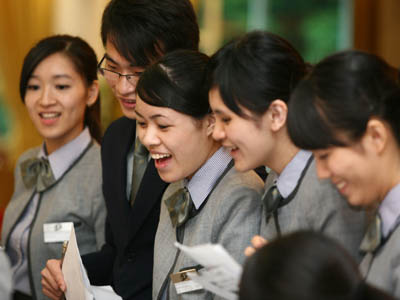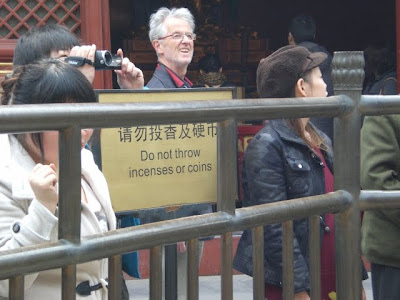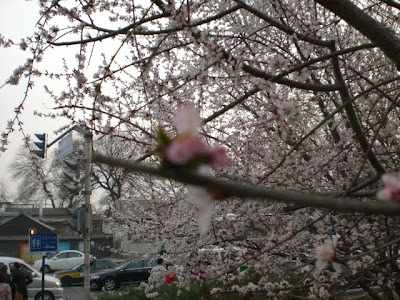Ni hao!
We got an early start on Thursday morning. After getting ready very quickly in our room, we went to the lobby for a very delicious (and cheap!) breakfast. Margarida, Iris, and I finished breakfast and caught a taxi for our first landmark of our Beijing trip: The Forbidden City.
We were dropped off in the back entrance, and instantly we were struck by its size. Of course, you would expect something called a “city” to be large, but it seemed like the high wall of the Forbidden City stretched on in both directions forever. What was more impressive was that it was surrounded by a large moat, making it seem truly castle-like and mysterious.

We purchased our entrance tickets, but we were a little irritated that the high tourist season prices went up 20 Yuan starting April 1, the day we were there! However, it didn’t take away from our excitement of being in the Forbidden City, one of the coolest places in China!
The Forbidden City was really amazing. The architecture was absolutely spectacular, and it was so easy to imagine an emperor living here with all his wives, servants, and guards. It was so incredibly large, and I’m sure we barely saw even half of it, even though we spent almost four hours there just walking through all the sections.

Again, we were stopped by a few people asking for our pictures, but poor Iris was often left out. Although she has beautiful blue eyes, her long, black hair makes her look Chinese from behind, haha!
When we emerged at the front entrance of the Forbidden City, we were directly across the street from Tiananmen Square, which is where the infamous massacre of protesting students occurred. The iconic image of Chairman Mao hanging above the front entrance of the Forbidden City was also there.
It was so cool to see the picture of Chairman Mao, so naturally I stopped to take a picture. However, there were rows of guards lining the five bridges (five is a lucky number) into the city, and they told us to keep moving it along.

To be honest, all the guards there made me a bit nervous. They all had red armbands around the arms of their uniforms, reminding me that I was in a communist country that has some political issues with my own nation. I was an alarming realization at first, but seeing many other Western tourists around made me feel a bit better.
We explored Tiananmen Square a bit, which is surrounded by four buildings with a monument in the middle. I found it a little strange that there was a security check before entering the square (which is surrounded by small fencing), but we had no problems and entered quickly.

Another interesting point to note is the fact that there are security checks before entering the subways, and you have to put your bags through a metal detector. I suppose it makes sense in this age of terrorism, but I can’t imagine the early morning rush hour being slowed down by these security checks.
In front of the Forbidden City, across Tiananmen Square, was the mausoleum of Mao Zedong. It’s only open in the morning, from 8:00 to noon, so we weren’t able to go inside. But apparently the corpse of Mao Zedong is on full display inside! You can actually see his body resting inside a glass case! I’m not sure how I would feel about getting that close to a dead body, but apparently many Chinese nationals make the journey to see him and bring flowers.

One thing we kept our eyes open for was a tribute to the Tiananmen Square Massacre, but we didn’t see anything that even mentioned it. In fact, the massacre is a taboo topic in mainland China, and you will have a very hard time finding any information on it in books or the internet. It was almost surreal knowing about all the censorship around me. I looked around at the locals and wondered if they knew how much censorship was actually going on.
After asking for directions from one of the security staff (we had a map, so all he had to do was point for us), we set off for the Beijing Hotel, the oldest hotel in Beijing! It was a bit of a relief to get out of Tiananmen Square, away from all the guards and security and whatnot. It was making me so uncomfortable, and once we were out of the square I felt like I could breathe again.
We had a bit of difficulty finding the hotel, since it was part of a line of hotels that all had similar names. But at last we found it! Apparently it was originally built in 1911, but it didn’t seem all that old to me. In fact, the lobby seemed like it had been renovated only a few years prior.

We wanted to have lunch, but it was 2:00 and lunch was just ending in the hotel restaurant. The teatime set started at 3:00, so we decided to explore the hotel a little bit to kill some time.
It’s such a beautiful, upscale hotel, and we had a great time exploring. Downstairs was the event space, which was exciting for me to see, since I want to be a hotel event planner one day. It was set up for a banquet buffet, but no one was down there so we didn’t stay too long (in case we weren’t supposed to be there).
The hotel was attached to the Beijing Regency Hotel by a few floors of upscale shopping. We browsed for a little bit, and then took the elevator to the top floor to see what the room arrangements were like. We couldn’t see into any of the rooms, but we did find a VIP floor. There was a woman at the top of the stairs, and she wouldn’t let us enter.
Around 2:45 we went down to the restaurant and asked if we could just have some drinks before the teatime set. Margarida and Iris both had a cappuccino, which came on a fancy plate with some cookies. I ordered a Coke (something I’ve become addicted to here in Asia, since it’s the only thing I know how to order when there’s a language barrier). For some reason I still can’t figure out, my Coke was only 5 Yuan less than their fancy cappuccinos with the cookies, which were around 45 Yuan (USD $6). Expensive glass of Coke.
We ordered the teatime set, which feeds three people and is only 80 Yuan (USD $12), and we split the price three-way between us. I’m still trying to wrap my head around the super-expensive drinks and the cheap tea set, which was filled with fancy cakes and cookies, and should have been much more expensive in this fancy hotel.

After teatime we tried to take a taxi to the Hong Qiao Pearl Market. However, each taxi driver we talked to tried to bargain the taxi fare with us before we got in, which irritated us. They were starting at 50 Yuan, some even 80, when we knew it shouldn’t even be 20. We found another hotel and asked the Assistant Manager if their bellboy could call us a metered taxi. We were very frustrated at that point, but the staff was very accommodating and called us a metered taxi. Unfortunately, we found ourselves having to ask hotels to call us metered taxis quite often during our trip.
At last they found us our taxi to the Hong Qiao Pearl Market (only 13 Yuan). Margarida and I had both promised our mothers we would bring back cheap pearls for them, so we were on a mission, prepared to bargain to the lowest prices possible. My Chinese roommate, Cindy, had told me that a good rule of thumb was to bargain down to a third of the price, so I kept that in mind as I did my shopping.

The Pearl Market was actually a large building with about five floors just full of kiosks selling not only pearls, but everything you could possibly imagine! Most of the floors had lots of pearl and bead sellers, but there was also a floor just for clothing (with both Chinese silks and knock-off Western brands) and another floor for electronics (NEVER buy electronics in China). There were also lots of arts and crafts on these floors, and I bought so much here like little dolls, scroll paintings, and even had some calligraphy done for my family.

I had a few people quote me some prices for a strand of pearls (just the beads, not necklaces) before I began bargaining. They were alright, but I finally found one woman that I really liked. She showed me how to differentiate real pearls from the fake ones (I only know the trick where you scratch it on your teeth, which is kinda gross when you don’t know how many people have touched them). I bargained down a strand of decent pearls to 25 Yuan ($3.50), and afterwards she even complimented me about what a good bargainer I was (she didn’t look too happy). But she got over it when I bought a few strands and brought my friends back later. She gave me her card, and I asked if she shipped overseas so my mom could buy more.
I didn’t fare so well with my other purchases. I bought one pretty scarf for my mother, which was her favorite shade of peach. When I opened the scarf at home I found a small gray stain on it. I also bought a pair of silk ties for my dad. The price tag said 400 Yuan for each, but I was able to bargain it down to 300 Yuan for two. However, I found the same ties later at a local market for 68 Yuan, and it was buy one, get one free. Oh well, you win some, you lose some.
The only problem with the Hong Qiao Pearl Market was that it was a Westerner’s tourist spot, and the locals selling their wares there know that. They charge outrageous prices! They quote you one price on a calculator, but tell you that just for you they’ll give a special discount, which is considerable, but still outrageous. A regular Western tourist, who probably has a lot of money at their disposal if they’re able to vacation in Beijing, probably won’t even bargain. They end up paying ridiculous prices for cheaply-made products and getting ripped off.
But there are some tricks you can do to get around it. Some people claim that they’re local, and that they know the real price. For me, I asked around the other kiosks for a price estimate, since you can find the same exact thing at dozens of other kiosks on the same floor. You also see how far you can push them. If you walk away and they call you back, you can still get them to go lower. If they let you walk away, you know you need to raise your price a bit.
They’re really nice, but they’re excellent salespeople. They flatter you, tell you what a great bargainer you are (“What a smart girl!”), and whatnot, but in the end you just have to stick by your original price. In this place, you could get them to go down to about a tenth of the price, I kid you not!
My friend Margarida was just browsing some of the Chinese silk robes at one kiosk. When she asked the young sales assistant the price, she quoted her 800 Yuan. Margarida just laughed and tried to walk away, but the girl kept throwing her lower prices. Margarida said she’d think about it and come back, but the girl wouldn’t have it and grabbed her arm! She wouldn’t even let Margarida walk away. At last she was down to around 60 Yuan (down from 800, mind you), and at this point, Margarida was just irritated. Finally, after about fifteen minutes, she got away, and from that point on we avoided that spot.
We went up to the roof for a breather, and we were very surprised. It was a beautiful rooftop garden, complete with a little pond with its own bridge and a gazebo with benches. We had a lovely view of the Temple of Heaven in the distance. We realized how physically exhausted we were after that crowded market, and how mentally exhausted we were from all that bargaining.

We tried to get another taxi back to our hostel, but no one would use their meter! Frustrated, I suggested we try to bargain down to 20 Yuan, since it was rush hour traffic and the chances of a metered taxi were slim.
A man in a tut-tut came by and asked for 50 Yuan, but we laughed since it only seats two. We kept asking other taxis, but the man in the tut-tut just kept following us and offering lower prices. Finally, we accepted, realizing that this would be a very interesting adventure fitting the three of us in a tiny, tiny tut-tut. And it certainly was very amusing. : )

After dropping our shopping bags at the hostel, we went out for dinner at a restaurant Margarida and I had found during our walk the previous night. Beijing is renowned for its special dish, the Peking Roast Duck, and you can’t go to Beijing without trying it. We had an interesting time ordering with the language barrier, but it worked out and we enjoyed our delicious duck!
We decided to nickname the duck “Chinese fajitas,” since you eat them in a similar way. They give you small flour wraps, and you load up the duck, spring onion, cucumber, and the sweet, delicious sauce and wrap it up like a fajita. It was one of the tastiest meals I’ve had in Asia, and we ate until it was all gone! For dessert we had fried banana balls, which were also pretty good, but nothing compared to the Peking Roast Duck.

After dinner we met our friend Camelia (Bulgaria) for drinks at Beijing’s most famous Bar Street area. It was so beautiful, with all the Christmas lights in the trees and the pretty view of the river. Later on in the week we went back during the day, and the view is absolutely breathtaking. We went to a couple of interesting places. The first one was a cool bar, but I guess it was a slow night because we were the only ones there. The second was a bit more packed, but I was confused by all the Christmas decorations of Santa in April.

Finally, we decided to call it a night. We found a (metered) taxi back to our hostel, where we took cold showers and crashed for the night. It was definitely our longest day in Beijing (and longest post, I promise) for the entire time we were there, and I decided that from then on I wanted to take it a little bit easier and actually enjoy my vacation.
Coming up next, “Beijing, Day Three.”
Kati























































